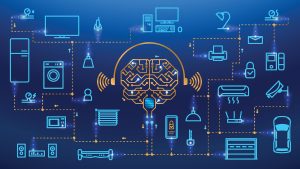AI and Cybersecurity: A New Era
In recent years, artificial intelligence (AI) has rapidly become an integral tool in various industries, reshaping processes, decision-making, and efficiencies. One of the most significant areas where AI is making a profound impact is cybersecurity. With the increasing sophistication of cyberattacks, the need for AI-based solutions has never been more critical. This article explores how AI is transforming the cybersecurity landscape, focusing on its benefits, key applications, and real-world examples, while highlighting case studies and market trends.
Impact of Artificial Intelligence on Cybersecurity Market Trends

As the digital world expands, so does the volume and complexity of cyber threats. From data breaches to ransomware attacks, traditional cybersecurity measures often struggle to keep pace. This has led to a growing demand for AI-based solutions in cybersecurity. According to Acumen Research and Consulting, the artificial intelligence in cybersecurity market is projected to grow significantly between 2022 and 2030, driven by factors such as the increasing number of cyberattacks and the need for real-time detection and response systems.
AI’s ability to analyze vast amounts of data, detect patterns, and adapt to new threats in real-time is transforming the way companies safeguard their data and systems. Its integration into cybersecurity tools allows businesses to respond to threats more quickly and effectively than ever before, leading to a substantial reduction in potential damage.
Future of AI in Enhancing Cybersecurity Threat Detection
AI’s future role in cybersecurity is undeniable. Traditional security measures often rely on static defenses, such as firewalls and intrusion detection systems, which are not always effective against evolving threats. AI, however, offers dynamic solutions. Machine learning (ML), a subset of AI, can continuously analyze network traffic, detect abnormal patterns, and alert security teams in real-time.
For example, AI-based solutions can identify anomalies that might indicate phishing attempts, malware infections, or insider threats. As cyber threats evolve, AI can adapt, learning from previous attacks to better anticipate future ones. This adaptability is crucial for businesses aiming to stay ahead in an increasingly hostile cyber environment.
Artificial Intelligence Applications in Cybersecurity for 2024
The application of AI in cybersecurity is vast, and its potential continues to grow. By 2024, experts predict that AI will be a central component in most cybersecurity strategies across industries. Some key AI applications in cybersecurity include:
- Behavioral Analytics: AI can analyze user behavior on networks to detect deviations that may indicate a breach. This application is particularly effective in identifying insider threats.
- Automated Incident Response: AI-powered systems can automate responses to specific types of threats, such as isolating infected systems or blocking malicious IP addresses.
- Threat Hunting: AI can assist security teams in proactive threat hunting, scouring networks for potential vulnerabilities or ongoing attacks that may not trigger traditional alarms.
- Fraud Detection: In sectors like finance, AI is widely used for fraud detection, analyzing transaction patterns in real-time to identify suspicious activity.
How AI is Transforming Cybersecurity in Financial Institutions
Financial institutions are prime targets for cybercriminals due to the sensitive nature of their data. In response, many financial firms are turning to AI-based cybersecurity tools to protect their networks and customers. For example, AI helps banks detect and prevent fraudulent transactions by analyzing vast datasets in real-time.
An excellent case study is JPMorgan Chase’s implementation of AI-driven security solutions. The bank uses AI to monitor its network for suspicious activity, analyze patterns in customer transactions, and predict potential fraud attempts before they occur. This proactive approach has significantly reduced fraudulent activities, safeguarding both the bank and its customers.
AI-Based Solutions for Cybersecurity Threats and Vulnerabilities

One of the most promising aspects of AI in cybersecurity is its ability to identify and address vulnerabilities before they can be exploited. AI can process large volumes of data from various sources, including network traffic, system logs, and user activity, to detect vulnerabilities. It then analyzes this data to provide actionable insights, allowing security teams to address potential weaknesses before they are exploited by cybercriminals.
For example, IBM’s AI-powered security platform, QRadar, uses machine learning algorithms to analyze data from across an organization’s network. The system can identify vulnerabilities, prioritize risks, and suggest the best course of action to mitigate them. This AI-driven solution not only improves security posture but also reduces the time and resources required to manage vulnerabilities.
Importance of AI in Preventing Cyberattacks in Global Industries
Cyberattacks are not confined to any specific industry, affecting organizations across sectors such as healthcare, manufacturing, and energy. AI is playing a pivotal role in preventing these attacks by providing organizations with the tools to detect threats faster and respond more effectively.
A notable case study is in the healthcare sector, where AI has been deployed to protect patient data. With the rise of telemedicine and electronic health records (EHRs), healthcare organizations are increasingly vulnerable to data breaches. AI-powered tools can monitor network traffic for suspicious activity, identify potential data leaks, and automate the response to mitigate the impact of an attack.
Artificial Intelligence Cybersecurity Market Growth Forecast 2022-2030
The global AI in cybersecurity market is expected to grow at a compound annual growth rate (CAGR) of 24.3% from 2022 to 2030. The primary drivers of this growth include the increasing adoption of IoT devices, the rising number of cyber threats, and the growing demand for cloud-based security solutions.
This market growth is also being fueled by the need for businesses to comply with regulatory requirements, such as the General Data Protection Regulation (GDPR) and the California Consumer Privacy Act (CCPA). AI’s ability to automate compliance processes, monitor data flows, and detect potential violations is making it an essential tool for businesses aiming to meet these regulatory demands.
Role of AI in Defending Against Evolving Cybersecurity Challenges
Cyber threats are constantly evolving, with hackers using increasingly sophisticated techniques to breach networks. AI is uniquely positioned to defend against these challenges. By leveraging machine learning algorithms, AI can quickly identify new attack vectors and update its defenses accordingly.
For example, Deep Instinct, an AI-powered cybersecurity company, has developed a platform that uses deep learning to prevent zero-day attacks. The platform continuously learns from past attacks, allowing it to predict and prevent new ones. This proactive approach has proven highly effective in defending against ransomware and other advanced threats.
Advanced AI-Driven Tools for Improving Cybersecurity Measures

AI-driven tools are revolutionizing the way organizations manage their cybersecurity efforts. These tools can automate routine tasks, such as patch management and vulnerability assessments, freeing up security teams to focus on more complex issues. Additionally, AI can provide advanced threat intelligence, helping organizations to better understand the nature of the threats they face.
One such tool is Darktrace, an AI-driven cybersecurity platform that uses machine learning to detect and respond to cyber threats in real-time. Darktrace’s AI analyzes network activity and user behavior, enabling it to detect subtle signs of a breach before it can cause significant damage.
Integrating Artificial Intelligence into Cybersecurity Strategies for Businesses
For businesses to fully leverage the benefits of AI in cybersecurity, it is essential to integrate AI into their overall cybersecurity strategies. This involves not only implementing AI-powered tools but also training staff on how to use these tools effectively. Businesses must also ensure that their AI systems are regularly updated to keep pace with evolving threats.
A successful example of AI integration is Google’s use of AI to protect its vast cloud infrastructure. Google employs AI to monitor its networks for potential threats, analyze user behavior, and automatically respond to incidents. This comprehensive approach has allowed Google to maintain a robust security posture while minimizing the risk of data breaches.
Benefits of AI in Cybersecurity
AI brings several significant benefits to the field of cybersecurity:
- Speed and Efficiency: AI can process and analyze data much faster than humans, allowing for real-time threat detection and response.
- Scalability: AI systems can handle vast amounts of data, making them ideal for large organizations with complex networks.
- Accuracy: AI can identify subtle patterns that may indicate a threat, reducing the likelihood of false positives.
- Cost Savings: By automating routine tasks, AI reduces the workload on security teams, allowing them to focus on higher-level issues and reducing operational costs.
Conclusion
AI and cybersecurity are entering a new era where traditional security measures are no longer sufficient to protect against the ever-growing range of cyber threats. By leveraging the power of AI, businesses can stay ahead of attackers, detect threats in real-time, and automate responses to mitigate the damage of cyber incidents. As the AI in cybersecurity market continues to grow, we can expect to see even more innovative solutions that will help organizations defend against the increasingly complex landscape of cyber threats.










